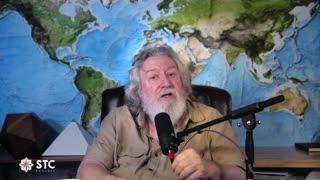An aurora[a] (plural: auroras or aurorae),[b] also commonly known as the polar lights,[c] is a natural light display in Earth's sky, predominantly seen in high-latitude regions (around the Arctic and Antarctic). Auroras display dynamic patterns of brilliant lights that appear as curtains, rays, spirals, or dynamic flickers covering the entire sky.[3]
Auroras are the result of disturbances in the magnetosphere caused by the solar wind. Major disturbances result from enhancements in the speed of the solar wind from coronal holes and coronal mass ejections. These disturbances alter the trajectories of charged particles in the magnetospheric plasma. These particles, mainly electrons and protons, precipitate into the upper atmosphere (thermosphere/exosphere). The resulting ionization and excitation of atmospheric constituents emit light of varying colour and complexity. The form of the aurora, occurring within bands around both polar regions, is also dependent on the amount of acceleration imparted to the precipitating particles.
Most of the planets in the Solar System, some natural satellites, brown dwarfs, and even comets also host auroras.
#aurora #auroras #northpole #southpole
The word "aurora" is derived from the name of the Roman goddess of the dawn, Aurora, who travelled from east to west announcing the coming of the sun.[4] Ancient Greek poets used the corresponding name Eos metaphorically to refer to dawn, often mentioning its play of colors across the otherwise dark sky (e.g., "rosy-fingered dawn").[5]
The words "borealis" and "australis" are derived from the names of the ancient gods of the north wind (Boreas) and the south wind (Auster).
Most auroras occur in a band known as the "auroral zone",[6] which is typically 3° to 6° wide in latitude and between 10° and 20° from the geomagnetic poles at all local times (or longitudes), most clearly seen at night against a dark sky. A region that currently displays an aurora is called the "auroral oval", a band displaced by the solar wind towards the night side of Earth.[7] Early evidence for a geomagnetic connection comes from the statistics of auroral observations. Elias Loomis (1860),[8] and later Hermann Fritz (1881)[9] and Sophus Tromholt (1881)[10] in more detail, established that the aurora appeared mainly in the auroral zone.
In northern latitudes, the effect is known as the aurora borealis or the northern lights. The former term was coined by Galileo in 1619, from the Roman goddess of the dawn and the Greek name for the north wind.[11][12] The southern counterpart, the aurora australis or the southern lights, has features almost identical to the aurora borealis and changes simultaneously with changes in the northern auroral zone.[13] The aurora australis is visible from high southern latitudes in Antarctica, Chile, Argentina, South Africa, New Zealand and Australia. The aurora borealis is visible from being close to the center of the Arctic Circle such as Alaska, the Canadian Territories, Iceland, Greenland, Norway, Sweden, Finland and Russia. On rare occasions the aurora borealis can be seen further south, for example in Estonia, Latvia, Lithuania, Scotland, Ireland, Denmark, and the northern part of the contiguous United States.
A geomagnetic storm causes the auroral ovals (north and south) to expand, bringing the aurora to lower latitudes. The instantaneous distribution of auroras ("auroral oval")[6] is slightly different, being centered about 3–5° nightward of the magnetic pole, so that auroral arcs reach furthest toward the equator when the magnetic pole in question is in between the observer and the Sun. The aurora can be seen best at this time, which is called magnetic midnight.
Auroras seen within the auroral oval may be directly overhead, but from farther away, they illuminate the poleward horizon as a greenish glow, or sometimes a faint red, as if the Sun were rising from an unusual direction. Auroras also occur poleward of the auroral zone as either diffuse patches or arcs,[14] which can be subvisual.
-
 46:57
46:57
Crime Circus
18 hours agoApple River ST*BBING!! Stand Your Ground Interrogation of Man in Wisconsin
2151 -
 9:39
9:39
Tactical Advisor
21 hours agoHow To Improve Your Shooting For FREE! Mantis Blackbeard X
4952 -
 1:00:59
1:00:59
Squaring The Circle w/ Randall Carlson
18 hours ago#007 The Real Climate Crisis Noone Is Talking About and Mount Tambora Pt 2
1.54K3 -
 13:52
13:52
America Uncovered
18 hours agoEveryone is WRONG About Trump's Guilty Verdict
1.22K9 -
 13:10
13:10
Censored TV
17 hours agoThe Owen Benjamin vs Jim Goad debate was WILD
1.5K10 -
 25:27
25:27
Degenerate Plays
9 hours agoThe Microtransaction Master - Call Of Duty Modern Warfare Remastered : Part 3
108 -
 21:03
21:03
MYLUNCHBREAK CHANNEL PAGE
12 hours agoOld World Minnesota?
3.8K15 -
 5:49:05
5:49:05
Akademiks
18 hours agoDrake Next Move - Whats next?? Did Lil Baby Listen to Me? Diddy and Family Preparing for Indictment?
55.4K27 -
 1:56:06
1:56:06
TimcastIRL
1 day agoTrump Raises RECORD $52.8 MILLION In One Day, Bonus Uncensored Show w/Laura Loomer | Timcast IRL
75.8K343 -
 23:19
23:19
Scammer Payback
4 days agoWe Created the First Ever 𝗔𝗡𝗧𝗜-𝗦𝗖𝗔𝗠 Call Center
205K244